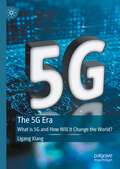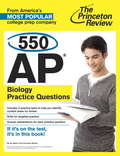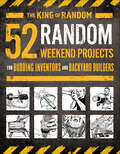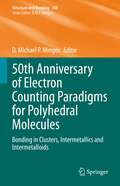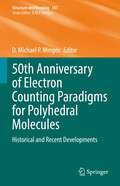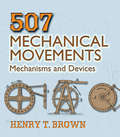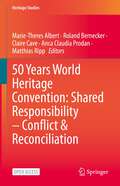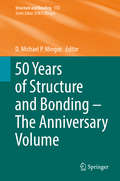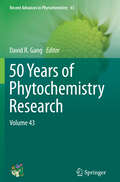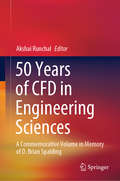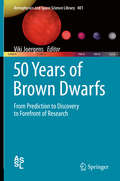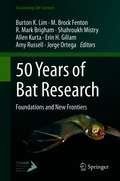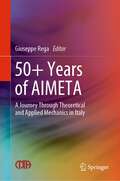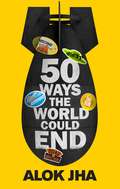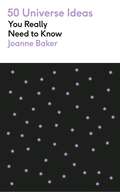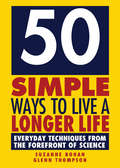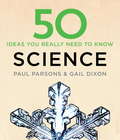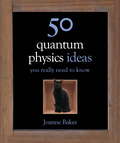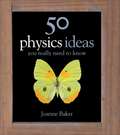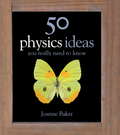- Table View
- List View
The 5G Era: What is 5G and How Will it Change the World?
by Ligang XiangThis book states that the seventh information revolution is the intelligent Internet, and 5G is the foundation of the seventh information revolution. This book gives a clear introduction to the three major scenarios, six characteristics, core technologies, and global landscape of 5G, and answers "What is true 5G?" This book also gives an in-depth explanation of 5G-enabled traditional industries, and outlines the profound changes that 5G will bring to transportation, medical, industry, and agriculture. Finally, the author made bold assumptions about the opportunities and challenges that human society faces in the post-5G era. For readers who want to fully understand 5G, this book provides an important reference and is a must-have book.
550 AP Biology Practice Questions
by Princeton ReviewTHE PRINCETON REVIEW GETS RESULTS. Get extra preparation for an excellent AP Biology score with 550 extra practice questions and answers. This eBook edition has been formatted for on-screen viewing with cross-linked questions, answers, and explanations. Practice makes perfect--and The Princeton Review's 550 AP Biology Practice Questions gives you everything you need to work your way to the top. Inside, you'll find tips and strategies for tackling and overcoming challenging questions, plus all the practice you need to get the score you want. Practice Your Way to Perfection.* 2 full-length practice tests and 16 practice drills covering each subject type* Practice drills organized by the 4 "Big Ideas"Academic and Strategic Explanations.* Detailed walk-throughs of free-response questions to help you write a winning essay* Answer keys and detailed explanations for each drill and test question Techniques That Actually Work.* Tried-and-true strategies to avoid traps and beat the test* Essential tactics to help you work smarter, not harder
52 Random Weekend Projects: For Budding Inventors and Backyard Builders
by The King of RandomFrom one of the most popular project channels on YouTube comes a how-to book on building things that go boom. Grant Thompson, "The King of Random," has created one of the most popular project channels on YouTube, featuring awesome videos such as How to Make a Laser Assisted Blowgun and Assassin’s Micro Crossbow. He currently has almost 10 million subscribers, posts 5 times a week, and averages over 40 million views a month.Partnering with Grant is Ted Slampyak, the artist behind the #1 New York Times bestseller 100 Deadly Skills.52 Random Weekend Projects: For Budding Inventors and Backyard Builders is a guide that enables ordinary folks to build an impressive arsenal of projects. These crafts combine some of Grant’s most popular projects—Matchbox Rockets, Pocket Slingshot Super Shooters, Proto-Putty, Ninja Balls, Mini Matchstick Guns, The Clothespin Pocket Pistol—with many new ones, providing clear instructions on how to build them step-by-step.Broken down into Beginner, Intermediate, and Advanced sections, 52 Random Weekend Projects is loaded with truly amazing projects, including:- Mousetrap Handgun- Mini Solar Scorcher- Air Vortex Canon- Air Mounted Skewer Shooter- Paracord Bullwhip- Bottle Cap Party Whistle- Ninja Stress Balls- Tablecloth Parachute- Skyblaster SlingshotAnd many more!
50th Anniversary of Electron Counting Paradigms for Polyhedral Molecules: Bonding in Clusters, Intermetallics and Intermetalloids (Structure and Bonding #188)
by D. Michael P. MingosThe 50 Year Anniversary of the development of electron counting paradigms is celebrated in two volumes of Structure and Bonding. Volume 2 covers applications to metal and metalloid clusters of the transition and post-transition elements
50th Anniversary of Electron Counting Paradigms for Polyhedral Molecules: Historical and Recent Developments (Structure and Bonding #187)
by D. Michael P. MingosThe 50 Year Anniversary of the development of electron counting paradigms for polyhedral molecules is celebrated in two volumes of Structure and Bonding. Volume 1 covers the historical development, theoretical models and applications to boranes and metalloboranes.
507 Mechanical Movements: Mechanisms and Devices
by Henry T. BrownEpicyclic trains, oblique rollers, trip hammers, and lazy-tongs are among the ingenious mechanisms defined and illustrated in this intriguing collection. Spanning the first century of the Industrial Revolution, this 1868 compilation features simplified, concise illustrations of the mechanisms used in hydraulics, steam engines, pneumatics, presses, horologes, and scores of other machines.The movements of each of the 507 mechanisms are depicted in drawings on the left-hand page, and the facing page presents a brief description of the item's use and operation. Ranging from simple to intricately complex, the mechanisms offer a fascinating view of the variety of small components that constitute complex machinery. A detailed index provides easy reference to specific mechanisms.Inventors, tinkerers, and anyone with an interest in the history of invention and technology will find this volume a treasury of information and inspiration.
50 Years World Heritage Convention: Shared Responsibility – Conflict & Reconciliation (Heritage Studies)
by Marie-Theres Albert Roland Bernecker Claire Cave Anca Claudia Prodan Matthias RippThis open access book identifies various forms of heritage destruction and analyses their causes. It proposes strategies for avoiding and solving conflicts, based on integrating heritage into the 2030 Agenda for Sustainable Development. It reflects on the identity-building role of heritage, on multidimensional conflicts and the destruction of heritage, and considers conflict-solving strategies and future perspectives. Furthermore, it engages theoretically and practically with the concepts of responsibility, reconciliation and sustainability, relating mainly to four Sustainable Development Goals, i.e. SDGs 4 (education), 11 (e.g. World Heritage), 13 (climate action) and 17 (partnerships for the goals). More than 160 countries have inscribed properties on the UNESCO World Heritage list since the World Heritage Convention came into force. Improvements in the implementation of the Convention, such as the Global Strategy for a Representative, Balanced and Credible World Heritage List, have occurred, but other conflicts have not been solved. The book advocates for a balanced distribution of properties and more effective strategies to represent the global diversity of cultural and natural heritage. Furthermore it highlights the importance of heritage in identity building.
50 Years of Structure and Bonding – The Anniversary Volume: The Anniversary Volume (Structure and Bonding #172)
by D. Michael P. MingosChemical structure and bonding. The scope of the series spans the entire Periodic Table and addresses structure and bonding issues associated with all of the elements. It also focuses attention on new and developing areas of modern structural and theoretical chemistry such as nanostructures, molecular electronics, designed molecular solids, surfaces, metal clusters and supramolecular structures. Physical and spectroscopic techniques used to determine, examine and model structures fall within the purview of Structure and Bonding to the extent that the focus is on the scientific results obtained and not on specialist information concerning the techniques themselves. Issues associated with the development of bonding models and generalizations that illuminate the reactivity pathways and rates of chemical processes are also relevant. The individual volumes in the series are thematic. The goal of each volume is to give the reader, whether at a university or in industry, a comprehensive overview of an area where new insights are emerging that are of interest to a larger scientific audience. Thus each review within the volume critically surveys one aspect of that topic and places it within the context of the volume as a whole. The most significant developments of the last 5 to 10 years should be presented using selected examples to illustrate the principles discussed. A description of the physical basis of the experimental techniques that have been used to provide the primary data may also be appropriate, if it has not been covered in detail elsewhere. The coverage need not be exhaustive in data, but should rather be conceptual, concentrating on the new principles being developed that will allow the reader, who is not a specialist in the area covered, to understand the data presented. Discussion of possible future research directions in the area is welcomed. Review articles for the individual volumes are invited by the volume editors.
50 Years of Phytochemistry Research: Volume 43 (Recent Advances in Phytochemistry #43)
by David R GangThis 43rd volume of RAP includes a total of seven articles based on talks presented at the 50th Anniversary meeting of the PSNA, which was held at the Fairmont Orchid, in Waikoloa, Hawai'i, USA. These seven Perspectives give a very good picture of the breadth of plant (bio)chemistry research in North America, which is also indicative of the state of the field worldwide. Each of these articles describes the integration of several different approaches to ask and then answer interesting questions regarding the function of interesting plant metabolites, either in the plant itself or in interactions with the environment (natural setting or human health application). Two Perspectives outline very clearly the power of approaching biological questions from a modern, "omics" or systems biology approach. Beale and Ward outline how metabolomics approaches can be brought to bear on plant biosynthetic questions and quickly lead to important advances in our understanding or how plants produce important metabolites. Zandkarimi et al. outline the integration of ion mobility spectrometry into mass spectrometry-based metabolomics investigations and show clearly how powerful those two spectrometric technologies can be when used together.
50 Years of CFD in Engineering Sciences: A Commemorative Volume in Memory of D. Brian Spalding
by Akshai RunchalProf. D. Brian Spalding, working with a small group of students and colleagues at Imperial College, London in the mid-to late-1960’s, single-handedly pioneered the use of Computational Fluid Dynamics (CFD) for engineering practice.This book brings together advances in computational fluid dynamics in a collection of chapters authored by leading researchers, many of them students or associates of Prof. Spalding. The book intends to capture the key developments in specific fields of activity that have been transformed by application of CFD in the last 50 years. The focus is on review of the impact of CFD on these selected fields and of the novel applications that CFD has made possible. Some of the chapters trace the history of developments in a specific field and the role played by Spalding and his contributions. The volume also includes a biographical summary of Brian Spalding as a person and as a scientist, as well as tributes to Brian Spalding by those whose life was impacted by his innovations. This volume would be of special interest to researchers, practicing engineers, and graduate students in various fields, including aerospace, energy, power and propulsion, transportation, combustion, management of the environment, health and pharmaceutical sciences.
50 Years of Brown Dwarfs: From Prediction to Discovery to Forefront of Research (Astrophysics and Space Science Library #401)
by Viki JoergensThe years 2012/2013 mark the 50th anniversary of the theoretical prediction that Brown Dwarfs, i. e. degenerate objects which are just not massive enough to sustain stable hydrogen fusion, exist. Some 20 years after their discovery, how Brown Dwarfs form is still one of the main open questions in the theory of star formation. In this volume, the pioneers of Brown Dwarf research review the history of the theoretical prediction and the subsequent discovery of Brown Dwarfs. After an introduction, written by Viki Joergens, reviewing Shiv Kumar's theoretical prediction of the existence of brown dwarfs, Takenori Nakano reviews his and Hayashi's calculation of the Hydrogen Burning Minimum Mass. Both predictions happened in the early 1960s. Jill Tarter then writes on the introduction of the term 'Brown Dwarf', before Ben Oppenheimer, Rafael Rebolo and Gibor Basri describe their first discovery of Brown Dwarfs in the 1990s. Lastly, Michael Cushing and Isabelle Baraffe describe the development of the field to the current state of the art. While the book is mainly aimed at the Brown Dwarf research community, the description of the pioneering period in a scientific field will attract general readers interested in astronomy as well.
50 Years of Bat Research: Foundations and New Frontiers (Fascinating Life Sciences)
by Burton K. Lim M. Brock Fenton R. Mark Brigham Shahroukh Mistry Allen Kurta Erin H. Gillam Amy Russell Jorge OrtegaWith more than 1,400 species, bats are an incredibly diverse and successful group of mammals that can serve as model systems for many unique evolutionary adaptations. Flight has allowed them to master the sky, while echolocation enables them to navigate in the dark. Being small, secretive, nocturnal creatures has made bats a challenge to study, but over the past 50 years, innovative research has made it possible to dispel some of the mystery and myth surrounding them to give us a better understanding of the role these animals play in the ecosystem. The structure of the book is based on several broad themes across the biological sciences, including the evolution of bats, their ecology and behavior, and conservation of biodiversity. Within these themes are more specific topics on important aspects of bat research, such as morphology, molecular biology, echolocation, taxonomy, systematics, threats to bats, social structure, reproduction, movements, and feeding strategies. Given its scope, the book will appeal to the wider scientific community, environmental organizations, and government policymakers who are interested in the interdisciplinary aspects of biology and nature.
50+ Years of AIMETA: A Journey Through Theoretical and Applied Mechanics in Italy
by Giuseppe RegaThe book retraces the history of the Italian Association of Theoretical and Applied Mechanics (AIMETA) since its establishment in 1965. AIMETA is the official Italian association of mechanics adhering to IUTAM (International Union of Theoretical and Applied Mechanics), which organizes and coordinates a meaningful number of research activities, the most important of which are the biennial National Congress and the internationally renowned journal “Meccanica”, published by Springer. Besides collecting and organizing all related important data and information, as far as possible, by distinguishing among the five scientific areas – general mechanics, solids, structures, fluids, machines – encompassed by AIMETA, the history of the association is assumed as a proper perspective to overview the evolution of theoretical and applied mechanics in Italy over about the last fifty years. This is accomplished in the first part of the book. with also a specific focus on the mechanics of solids and structures, where the biographies of a meaningful number of recognized Italian scholars of mechanics in all areas are also provided, along with testimonials and memories by a few senior people meaningfully involved with AIMETA and Italian mechanics. The second part gives an account, although unavoidably incomplete, of recent developments of mechanical sciences in Italy, as reflected also in the activities of AIMETA and with reference to the international context. Contributions by a number of invited senior scholars, still very active, consist of overviews on some scientific themes in the various areas, summaries of achievements of research groups, expressions of research viewpoints, prospects for future developments.
50 Ways the World Could End: The Doomsday Handbook
by Alok JhaDeath by Euphoria. Dysgenics. Population Death Spiral. Genetic Superhumans. Geomagnetic Reversal. Galactic Collision. Strangelets. Whether we like it or not, everything's going to come to a pretty unpleasant halt on our planet at some point in the future. What we don't know is what form our extinction is likely to take. In this accessible and entertaining book, acclaimed writer Alok Jha explains the head-spinning apocalyptic science behind 50 horrifying doomsday scenarios.
50 Ways the World Could End: The Doomsday Handbook
by Alok JhaDeath by Euphoria. Dysgenics. Population Death Spiral. Genetic Superhumans. Geomagnetic Reversal. Galactic Collision. Strangelets. Whether we like it or not, everything's going to come to a pretty unpleasant halt on our planet at some point in the future. What we don't know is what form our extinction is likely to take. In this accessible and entertaining book, acclaimed writer Alok Jha explains the head-spinning apocalyptic science behind 50 horrifying doomsday scenarios.
50 Universe Ideas You Really Need to Know (50 Ideas You Really Need to Know series)
by Joanne BakerIn a series of 50 accessible essays, Jo Baker introduces and explains all of the essential concepts, major discoveries and the very latest thinking in astrophysics.From heliocentrism to Newton's theory of optics, the theory of relativity to supermassive black holes, 50 Ideas You Really Need to Know: Universe is a complete introduction to the most important concepts about our universe.
50 Universe Ideas You Really Need to Know (50 Ideas You Really Need to Know series)
by Joanne BakerIn a series of 50 accessible essays, Jo Baker introduces and explains all of the essential concepts, major discoveries and the very latest thinking in astrophysics.From heliocentrism to Newton's theory of optics, the theory of relativity to supermassive black holes, 50 Ideas You Really Need to Know: Universe is a complete introduction to the most important concepts about our universe.
50 Simple Ways to Live a Longer Life
by Suzanne Bohan Glenn ThompsonIn 2011, the first wave of the 76 million Baby Boomers will reach age 65, and one in three American adults will be senior citizens. Everyone wants to know how to live the healthiest and longest life. 50 Simple Ways to Live a Longer Life is an easy-to-comprehend resource packed with the most amazing health discoveries from the forefront of science. It leaves readers inspired to take active roles in extending their own lives and improving their own health. Each chapter contains a different way to extend your life, plus a "Making It Real" section that tells readers what they specifically can do to achieve these benefits. 50 Simple Ways to Live a Longer Life offers fresh perspectives and intriguing information, even on those frequently covered topics like exercise and diet. This book is an affordable, easy-to-assimilate book that will help people add years and vigor to their life.
50 Science Ideas You Really Need to Know
by Gail Dixon Paul Parsons50 Science Ideas You Really Need to Know is your guide to the biggest questions and deepest concepts from across the whole of science. What was the Big Bang? How did life on Earth arise? What does quantum mechanics tell us about the universe? Is true artificial intelligence possible? And does life exist on other planets? Moving from the basics of atoms and molecules, Newton's laws of physics and the building blocks of life to the cutting edge of nanotechnology, Einstein's theories of relativity and cloning, this book makes the many worlds of science accessible and illuminating. Featuring fifty concise, insightful and illustrated essays covering physics and astronomy, Earth and life sciences, chemistry and materials, psychology and computing, and exploring the ways they connect with each other and impact on our lives, 50 Science Ideas You Really Need to Know is the ideal introduction to the questions which fascinate us all.
50 Quantum Physics Ideas You Really Need to Know (50 Ideas You Really Need to Know series)
by Joanne BakerA guide to everything you need and want to know about quantum physics, how our universe works and our existence in it. Quantum physics is the most cutting-edge, important and fascinating area of modern science. We have all heard of Einstein's theory of relativity and Schrodinger's Cat - but do we really understand the mind-bending theories of our universe?In 50 concise chapters, Joanne Baker covers the foundation concepts of quantum physics and moves on to present clear explanations of complex theories and their advanced applications - from string theory to black holes, and quarks to quantum computing. With informative two-colour illustrations alongside key ideas in straightforward, bite-sized chunks, this book will teach you everything you need to know about quantum physics - and challenge the way you understand the world. The ideas explored include: Theory of relativity; Schrödinger's cat; Nuclear forces: fission and fusion; Antimatter; Superconductivity.
50 Quantum Physics Ideas You Really Need to Know (50 Ideas You Really Need to Know series)
by Joanne BakerA guide to everything you need and want to know about quantum physics, how our universe works and our existence in it. Quantum physics is the most cutting-edge, important and fascinating area of modern science. We have all heard of Einstein's theory of relativity and Schrodinger's Cat - but do we really understand the mind-bending theories of our universe?In 50 concise chapters, Joanne Baker covers the foundation concepts of quantum physics and moves on to present clear explanations of complex theories and their advanced applications - from string theory to black holes, and quarks to quantum computing. With informative two-colour illustrations alongside key ideas in straightforward, bite-sized chunks, this book will teach you everything you need to know about quantum physics - and challenge the way you understand the world. The ideas explored include: Theory of relativity; Schrödinger's cat; Nuclear forces: fission and fusion; Antimatter; Superconductivity.
50 Quantum Physics Ideas You Really Need to Know (50 Ideas You Really Need to Know series)
by Joanne BakerIn a series of 50 accessible essays, Joanne Baker introduces and explains the fundamental physical concepts and laws that govern the inner workings of our universe.From Schrodinger's cat to Einstein's theory of relativity, energy conservation to speed of light, 50 Quantum Physics Ideas You Really Need to Know is a complete introduction to the most important quantum physics concepts in history.
50 Quantum Physics Ideas You Really Need to Know (50 Ideas You Really Need to Know series)
by Joanne BakerIn a series of 50 accessible essays, Joanne Baker introduces and explains the fundamental physical concepts and laws that govern the inner workings of our universe.From Schrodinger's cat to Einstein's theory of relativity, energy conservation to speed of light, 50 Quantum Physics Ideas You Really Need to Know is a complete introduction to the most important quantum physics concepts in history.
50 Physics Ideas You Really Need to Know
by Joanne BakerIn this, the second volume in an important new series presenting core concepts across a range of critical areas of human knowledge, author Joanne Baker unravels the complexities of 20th-century scientific theory for a general readership. From Hubble's law to the Pauli exclusion principle, and from Schrödinger's cat to Heisenberg's uncertainty principle, she explains ideas at the cutting-edge of scientific enquiry, making them comprehensible and accessible to the layperson.
50 Physics Ideas You Really Need to Know
by Joanne BakerWe encounter physics before we've even left the house in the morning; an alarm clock tracks time, a mirror reflects light waves and our mobile phones rely on satellites held in their orbit by gravity. Where would we be without the Bernoulli equation to explain how planes fly, electromagnetic waves enabling us to communicate around the world or the discovery of X-rays? In 50 Physics Ideas You Really Need to Know Joanne Baker will uncover the physics all around us, from basic concepts like gravity, light and energy through to the complexities of quantum theory, chaos and dark energy. Featuring short biographies of iconic physicists, explanatory diagrams and timelines showing discoveries within their historical context, this book is the perfect guide to the fundamental concepts of physics, making even the most challenging theories easy to understand. Contents include: Newton's law of gravitation, Brownian motion, Chaos theory, Fleming's right hand rule, Planck's law, Heisenberg's uncertainty principle, Schrodinger's cat, Superconductivity, Rutherford's atom, Nuclear fission and fusion, The God particle, String theory, Special and general relativity, The big bang and the Anthropic principle.
